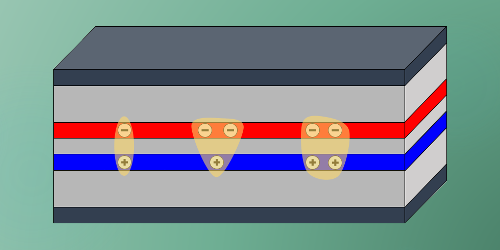Electron–Hole System Harbors Rich Phases
Electron–hole bilayers are semiconductor structures in which electrons and holes—positively charged electron vacancies—are separated into two distinct layers. These structures can host unusual phases of matter owing to the presence of both attraction between opposite charges and repulsion between like charges. However, most studies have focused only on the scenario in which the electron density is equal to the hole density. Now theoretical work by David Dai and Liang Fu at the Massachusetts Institute of Technology has explored the imbalanced case in which this electron–hole density ratio is 2:1 [1]. The researchers’ findings suggest that such an electron–hole bilayer has a remarkably rich phase diagram.
The imbalanced case is of particular interest for two key reasons. First, the presence of a net charge density causes the Coulomb interaction between the charges to become stronger than their other interactions, favoring unconventional phases in which the charges are strongly coupled to one another. Second, this setup could facilitate the formation of exotic particles called trions, made of two electrons in the electron layer bound to one hole in the hole layer.
Through a combination of theoretical analysis and numerical calculation, Dai and Fu predict the phase diagram for such an electron–hole bilayer. This diagram includes several previously unidentified phases, including a crystal composed of trions and a lattice of electrons through which bound electron–hole pairs called excitons permeate. The researchers show that these phases could be observable in electron–hole bilayers made of materials known as transition-metal dichalcogenides.
–Ryan Wilkinson
Ryan Wilkinson is a Corresponding Editor for Physics Magazine based in Durham, UK.
References
- D. D. Dai and L. Fu, “Strong-coupling phases of trions and excitons in electron-hole bilayers at commensurate densities,” Phys. Rev. Lett. 132, 196202 (2024).




